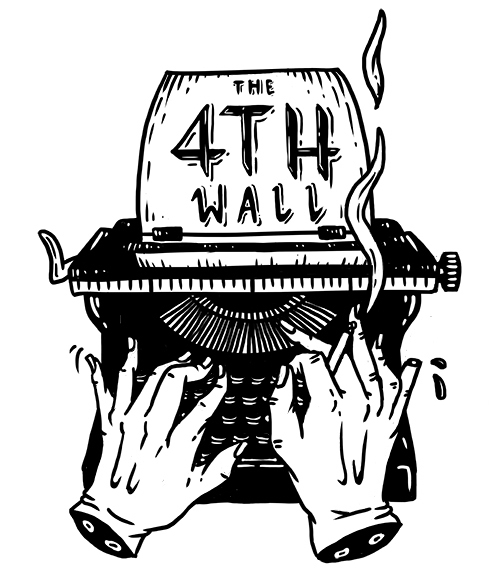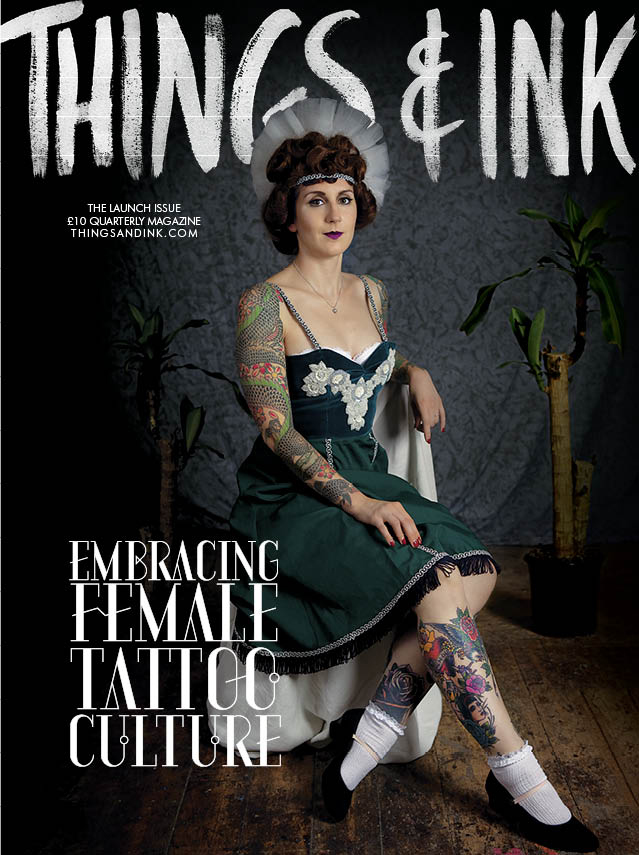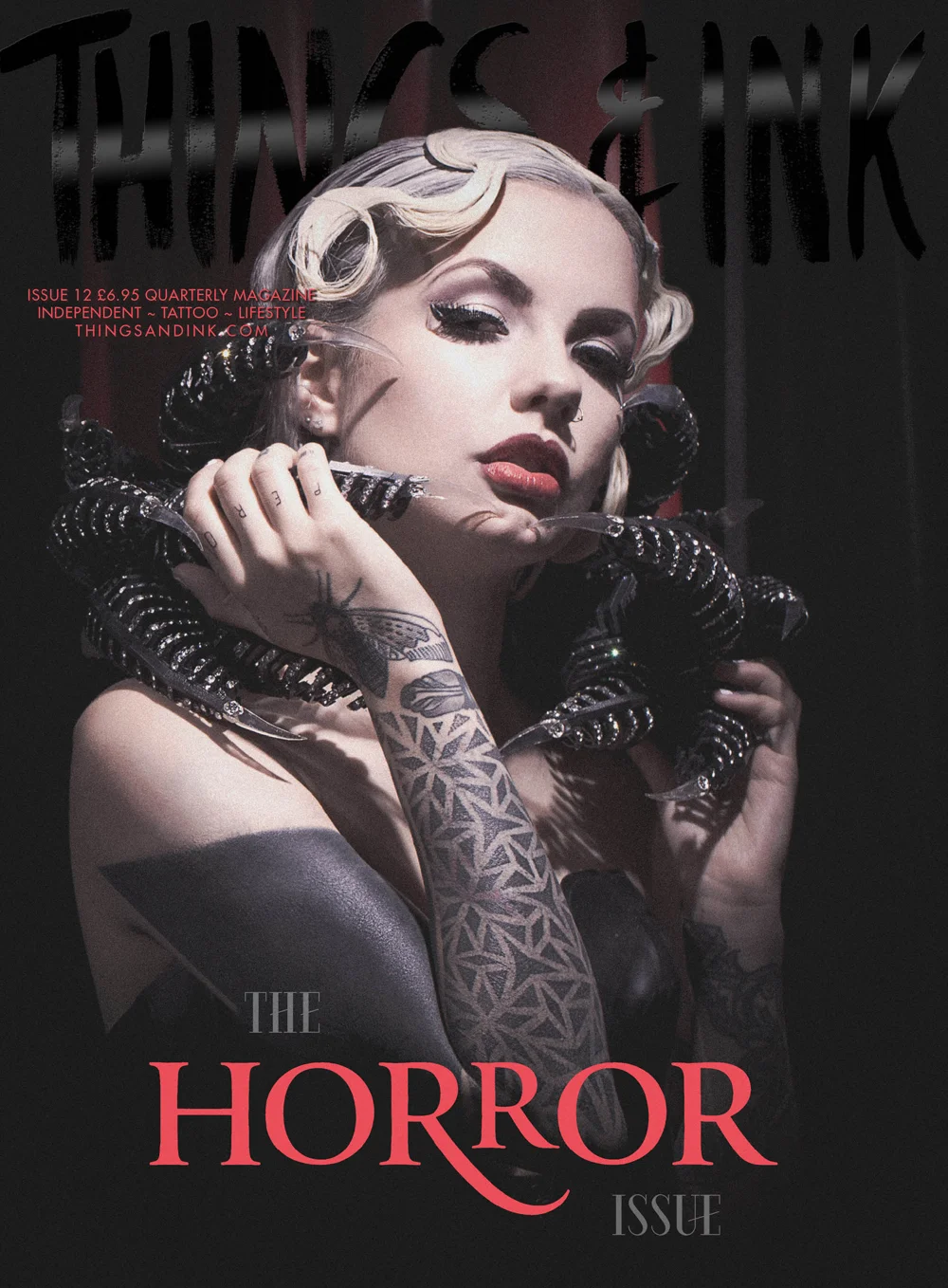Alice in Tattooland
As an avid tattoo consumer and publishing operative, Alice Snape had always felt that the magazines representing tattoo culture, with their half naked women sporting mediocre body art, catered more toward the loins of men than the art of ink.
So, naturally, she created her own.
Launched in 2012, Things&Ink’s unique blend of boutique lifestyle and tattoo subculture produced 12 beautifully curated female friendly issues. Although it has since made the transition from paper to digital, their dedicated community of tattoo lovers, both female and male, have remained loyal, populating their Facebook page and frequently visiting the blog.
I have a personal affinity with this magazine. While hauling through my master’s degree I was lucky enough to find solace in writing for Things&Ink. Both independent and niche, the magazine is undoubtedly a labor of love, and I enjoyed every interaction with Alice and the Things&Ink community. Needless to say, I was very excited to talk with Alice about the vicissitudes of starting a magazine and how her journey has been since.
Alice Snape, editor of Things&Ink.
So, how did you come to create Things&Ink?
I have worked in the publishing world since I graduated from my MA back in 2007. I did a degree in English Literature and Philosophy at Sheffield Uni, and didn’t know what the hell to do with it, so I did a Masters in Publishing in Oxford. I have always loved books and magazines. Books are a wonderful form of escapism, and magazines are a sort of commentary on the world, but in an inspirational format.
“They were also all very much geared towards men, with half naked women legs apart with barely any tattoos on the cover.”
I actually created a prototype of a female friendly tattoo magazine for my MA major project, I think it might still even be in the library at Oxford Brookes University. At the time, I was looking to get my first tattoo, I was 21, and this was before the days of Instagram, and I bought a load of tattoo magazines for inspiration. Needless to say none of them appealed to me, they were very much aimed at men and none of them featured tattoos that I like or would suit me and my tastes. They were also all very much geared towards men, with half naked women legs apart with barely any tattoos on the cover.
My tutors all raved about my prototype magazine and thought it would work in a real world situation… however I was young and inexperienced and didn’t feel at all ready to launch my own magazine. So, I started work in the publishing world, first at an arts organisation, then as a writer and sub-editor, mainly on women’s lifestyle titles.
Things&Ink launch issue.
I launched Things&Ink back in 2012. As I still didn’t feel that tattoo magazines related to me, I was also disillusioned with women’s magazine – I didn’t want Photoshopped covers or the latest diet… Things&Ink was an answer to this.
Over the three years Things&Ink was in circulation we printed 12 issues. Each had a different theme, carefully curated content and a tattoo artist on the cover with a photo shoot created around them and their work. I also didn’t want to just showcase tattoos, as with the rise of Instagram and blogs, many people find tattoos online rather than in magazines. Which leads me onto your next questions, I guess…
We sold around 2,000 copies per issue, all over the world, but mainly in the UK. Most sales came from online orders, as it is very difficult and costly to get an independent magazine onto the shelves in shops.
Alice.
Tell me more about Things&Ink’s unique point of difference?
“Fundamentally, I wanted to create a high-end magazine that wouldn’t look out of places on the shelves next to magazines such as Vogue and Dazed & Confused.”
I wanted the magazine to delve into tattoo culture, explore the reasons behind people getting their tattoos, from tattooing over scars to body confidence… I also wanted to feature tattoo artists and in-depth interviews about how their work has progressed, the ins and outs of their work, I also wanted to feature fashion, beauty and lifestyle that related to tattoo culture and also the history of tattoos – a mix I felt was missing from other mainstream tattoo mags. Fundamentally, I wanted to create a high-end magazine that wouldn’t look out of places on the shelves next to magazines such as Vogue and Dazed & Confused. Things&Ink reflected tattoos in the way I felt they should be – as art.
Things&Ink has evolved, it launched as a female tattoo magazine to give a voice for female tattoo artists and collectors, and although still a feminist title, it doesn’t only feature women. It was received mostly positively.
Things&Ink Horror issue
How was the transition from print to online?
Print is a very difficult and changing industry. People just don’t seem to buy magazines in the same way that they used to, and I am guilty of this too. There has been a rise in free magazines, which rely on advertising to run, yet a lot of advertisers are moving to online, as they can record click-throughs etc., so they know exactly how many hits / sales they have got from an advert. I thought about relaunching Things&Ink as a free, London-based title, giving it away at Tube stops etc., but I decided I wanted to concentrate on curating exhibitions and blog content – blogs and Instagram really work for tattoo culture.
Are there any tattoo subjects that you’re inordinately passionate about?
I believe that women with tattoos should not be objectified and fetishised. A tattoo on a woman’s skin is not an invitation to touch her. In the summer, when I wear less clothes, I can’t stand it if someone – male or female – touches me without my permission. That is never, ever, acceptable. I want tattoos to be described in a positive way in the media to combat this. I don’t want a woman to be described as slutty just because she has ink on her skin.
How do you view the growth and exposure of tattoo culture, and how does Things&Ink align in that vision?
I view it as a positive thing, although I know that many artists and purists preferred it when it was more “underground” and can get quite snobby about it. I think the bigger an industry gets, the more opportunity there is for “bad” work, scratchers if you will.
I hope that Things&Ink can continue to provide a platform for artists, and teach its readers how to choose the right artist for them. Some people will always just go to their nearest tattoo artist, as they see all “tattooists” as equal. Of course, as editors and experienced tattoo collectors, we know that isn’t the case. Artists and their work must be researched and you should go to an artist whose style you like. In my opinion, though, there will always be a place for tattoos that aren’t considered art – names, small symbols etc. – and there is absolutely nothing wrong with that. Some people do not want to be heavily tattooed or even get just one large tattoo.
Things&Ink Art issue
What have been some of your best and worst moments as editor?
There have been so many highs and lows. Putting together that first issue was so difficult. I slept so little and was working every hour possible on top of a full-time job. But the first day it sent for sale and we sold 100 copies I felt incredible. I got 2,000 copies printed and we sold out in the end.
I love coming up with shoot ideas and collaborating with artists and photographers to create content that is truly unique. Things&Ink looks nothing like your typical tattoo mag.
What are some memorable articles that you’ve published?
My most memorable was written for the Guardian commenting on the ban on visible tattoos in the Met police while I was compiling the launch issue.
And ‘Indeilible Ink', my personal take on tattoos.
And some memorable tattoos?
Recently this tattoo blew me away, really beautiful and stood out to me:
I find mastectomy tattoos fascinating and think this is such an interesting amazing take on one:
LOVE this one by Sadee Glover, it was the tattoo that made me want to get work from her:
And this, it has a really distinctive graphic style
This one stands out for the wrong reasons. I will never forget this flashing up on my Facebook news-feed. It was his first tattoo… it looks badly done and it is ON HIS FACE. But it throws up questions: if he is happy, who are we to judge?
Your top 5 tattooists and why:
Emily Rose Murray: I would love to get tattooed by her one day, the dream, her style has got that dreamy 1940s appeal that I love, I love her colour palette.
Cris Cleen: again this has a classic vintage appeal and he works in such a limited colour palette that his style is very recognisable and unique.
Claudia de Sabe: it was her work that made me realise I wanted to be heavily tattooed, just impeccable. (she was also the star for the cover of the first issue).
Aimee Cornwell: Her work blows me away. I have found it so interesting to watch her journey, her style has changed so much over the years and now she has such a magical artistic style.
And Rose Hardy.
And tattoo publications?
Total Tattoo: Good tattoo news and coverage of events.
Needlesandsins.com: editor Marisa Kakoulas is a lawyer and I find this to be a very insightful and trustworthy source.
And Inked.
I always use Instagram to discover new artists and follow artist’s work. You can’t get more up to date.
Some favourite artists:
Jack Vettriano: I have always adored his work, was one of my favourite artists. I am just drawn to his work and still love it even though it has now been mass produced.
Dante Gabriel Rossetti: I have a tattoo based on three of his paintings. I adore his pre raphaelite woman, flowing red hair.
Alphonse Maria Mucha: again, a classic.
Can you offer any tips for artists who want to get exposure?
NEVER email someone with no knowledge of who you are emailing, some people email me who have clearly never read the blog or magazine and have no idea what we are about. Why should a magazine publish your work if you have no idea what we do??
Also group emails are very annoying. We want to feel special too.
And for writers and photographers.
Again, it’s always good to show a knowledge of the publication and tailor your submission to it. Be chatty and be honest.
Do you have any tips for people wanting to get tattoos?
Yes, I wrote an article on advice for first timers!












